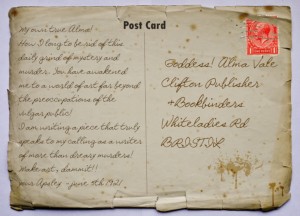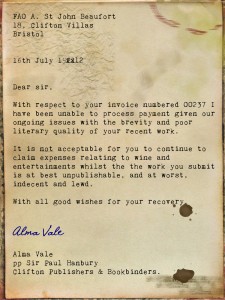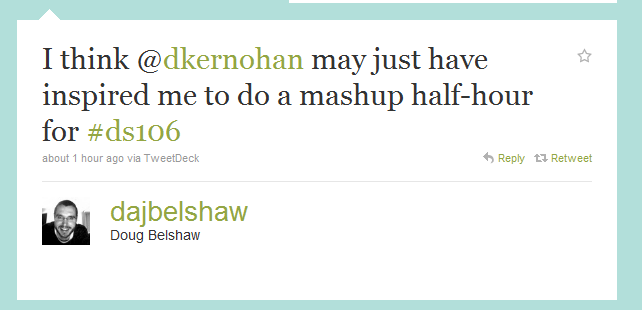I’m very pleased to have had the following paper accepted at this years British Conference of Cliftonian Studies, to be held at Rack’s Bar on St Paul’s road in the first week of August. The discovery of the Apsley St John Beaufort archive is a major step forward in our understanding of one of Bristol’s least known writers.
Abstract: following the initial work of Bohn (2011), Kernohan (2011) and Cullen (2011) I have been able to gain further access to the Apsley St John Beaufort (AStJB) papers, currently archived in the rare books collection of Redland Library, Bristol. Given the wealth of material available I chose to focus only on the late spring/early summer of 1912, already known to AStJB scholars as the period of his career-ending dalliance with an editorial assistant, Ms Alma Vale. With the permission of the Librarian of Redland Library I am able to display for the first time images of “lost” books, correspondence and a small section of an unpublished manuscript.
Background: If Apsley St John Beaufort is remembered at all by the general reader, it is as a minor provincial writer of rather superficial murder mysteries. Spanning around 10 years between 1900 and 1910, his oeuvre is said to span 20 short novels, of which only a handful have henceforth been available to even the devoted scholar of such work. AStJB’s unique charm, as it were, is drawn both from the claustrophobic setting of his work in the unremarkable Bristol suburb of Clifton and it’s environs, and the culinary background of central protagonist Gaston LeCreuset.
Discussion:
As an addition to the “Bibliography of Extant Works” (Bohn & Cullen, 2010) I am happy to be able to include images of four further works, long thought lost, taken from the recently discovered archives at Redland Library. Of the four, The Celeriac Manifesto (1906) and The Balsamic Caper (1907) stand amongst his finest work, both achieving to this reader – in passages – the heights of his acknowledge masterpiece The Clifton Triangle. In contrast The Dauphinoise Coalition (1905) is below average, and The Gorgonzola Approbation (1911) almost unreadably bad, far beneath the largely workmanlike quality the rest of his novels. All four books are from the 1937 reprinting, with their modish three-colour cover art.
As we know (Cullen 2010) The Gorgonzola Approbation was his final published work, written towards the end of his career in the summer of 1912. At this point, AStJB had become disenchanted with his writing and had taken to a louche and degenerate life around the fleshpots and houses of ill repute in neighbouring Colston Hill. However, with the newly discovered archive of correspondence we are now able to say with certainty that – to AStJB at least – this period represented a profound artistic awakening under the tutelage of his muse, Ms Alma Vale.

(Widely-read readers may appreciate AStJB’s use of a slogan current within certain online communities. As far as I am aware this is the first recorded use of the phrase, predating the better known use by Orwell in Down and Out in Paris and London by some 20 years)
We know vanishingly little of Ms Vale’s early life, but it appears she became an Editorial Assistant to Sir Paul Hanbury at Clifton Publishing sometime in 1911, at the tender age of 18. Most scholars (Bohn 2012) suspect that the affair was primarily in AStJB’s increasingly addled mind. Indeed, given his use of her name as a character in a The Celeriac Manifesto nearly 6 years earlier, we now have significant doubt as to her existence outside of AStJB’s gin-soaked imaginings.
However, the discovery of the following letter preserved in the Redland Archive suggests otherwise.

With the permission of the librarian, the letter has been submitted for forensic testing but early results appear to point to it being genuine. An immediate reading suggests that it confirms our initial theory that – although Ms Vale was an editorial assistant at the relevant time, she did not reciprocate AStJB’s advances.
We do know, however, that at around this time AStJB submitted the typed manuscript of an atypical novel owing much to the work of HG Wells. Clearly this was not suitable for the formulaic list of murder mystery novels at Clifton Publishing, and it is unclear why he felt it would be. Maddeningly, only one page of the manuscript has survived (AStJB’s habit of typing on only one side of very small notepaper was preserved even into his penury towards the end of his life).

It is difficult for the serious AStJB scholar to know what to make of this manuscript – the style and presentation are classic St John Beaufort but the content, despite a few familiar ticks (the emphasis of “indeed” framed in dashes for example), is almost entirely unrecognisable. He appears to be describing an arcade in something very similar to modern-day Clifton, including references to concealed lighting, plasma televisions, mobile phones – and one could imagine the “infernal machines” as either air conditioning or motor transport.
Conclusion:
The breadth and nature of the Redland Archive significantly challenges the accepted understanding of the brief career of Apsley St John Beaufort. Clearly, a concerted collaboration between scholars in the field is needed to conduct a proper survey of the treasures within.
Bibliography (in date order)
Bohn, M and Cullen, M, “Apsley St John Beaufort: A bibliography of extant works” (unpublished monograph, 2010)
Cullen, M, “The later career of Apsley St John Beaufort” in Journal of Cliftonian Studies issue 19 (Bristol, 2010)
Bohn, M, “Is the lost Apsley St John Beaufort archive in Redland Library Basement?” letter in Journal of Cliftonian Studies issue 22 (Bristol, 2011)
Kernohan, D, “Reply to a letter from Bohn” , letter in Journal of Cliftonian Studies issue 23 (Bristol, 2011)
Cullen, M, “Initial report: the Apsley St John Beaufort archive”, Proceedings of the 9th annual British Conference of Cliftonian Studies, (Bath, 2011)
Bohn, M, “The Dark Lady: Alma Vale and Apsley St John Beaufort”, Journal of Cliftonian Studies issue 27 (Bristol, 2012)
(1905)



























